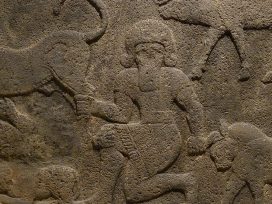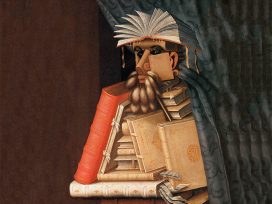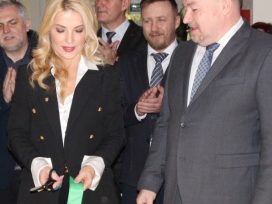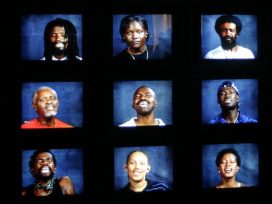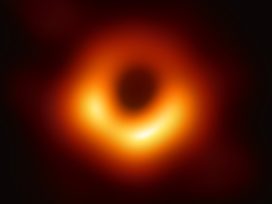‘Rightwing literature’ is a term widely used in contemporary Polish literary criticism. However, it begs many questions. Broadly speaking, the problems are twofold. First, there is no single ‘Right’ in Poland. The label ‘rightwing’ includes conservatives, nationalists and Catholics – and sometimes fascists and national socialists. It would be more accurate to refer to a range of rightwing groups that frequently clash with one another both ideologically and politically.
This was also the case in the interwar years. For example, in its early stages, the National Democratic Party (Endecja) was critical of Christianity and Christian Democracy and in constant disagreement with conservatives. In the 1920s and ’30s, the nationalist Right generally believed that the essence of ‘Polishness’ was bound up with Catholicism. Yet there were also nationalists who saw Christianity as a foreign influence and looked for the essence of Polish identity in pagan traditions.
Second, any concept of ‘the Right’ is not absolute. Its definition is relative and changes over time, generally in relation to what is perceived as ‘the Left’. As the political scientist Norberto Bobbio noted, ‘Right’ and ‘Left’ stand for a particular political topology that has nothing to do with ‘political ontology’.
The term ‘rightwing literature’ or ‘the literary Right’, also referred to as ‘nationalist literature’ or ‘the literature of the Polish conservative revolution’, is even more complicated. According to institutional criteria, it would cover writing published in rightwing journals, or by publishers who identify with the Right, as well as work by writers linked to rightwing organisations. If the criterion is the work’s reception, then rightwing literature is what readers decide falls into that category at any given time. If it is a work’s content, then the connection between a piece of writing and rightwing ideology is what counts. This connection might be expressed directly, through comments by the narrator or a fictional character, or indirectly in the form of a preference for particular topics, symbols, metaphors or genres. Here, the issue becomes that of the aesthetics of rightwing discourse – which are subject to change just as much as rightwing ideologies.
A writer’s political or ideological development also needs to be taken into account. Categorising a writer as the representative of ‘the literary Right’ may shed light on only a fragment of his or her literary output. Consider the poet Konstanty Ildefons Gałczyński (1905–1953), whose verses and political manifestos featured prominently in the nationalist weekly Prosto z mostu (‘Straight talking’) between 1935 and 1939. Yet, after 1946, Gałczyński became a supporter of the Communist regime, expressing his new political position in his poetry. The prose writer Jerzy Andrzejewski (1909–1983) followed a similar trajectory. Between 1935 and 1938, he published numerous essays in Prosto z mostu as well as excerpts from his Catholic novel Ład serca (‘The harmonious order of the heart’). After 1945, however, Andrzejewski became a champion of communism and, for a while, even joined the party. In 1957, however, he left to become an activist in the leftwing, anti-communist opposition.
Today, Jarosław Marek Rymkiewicz (b. 1935) is considered the most eminent rightwing writer in Poland. He publicly supports the conservative Law and Justice party and, in his frequent political commentaries, has revealed his proximity to rightwing positions. However, it would be a crude simplification to describe his poetry of the 1960s, or much of the work he published after 1989, as ‘rightwing’. It is worth noting that Rymkiewicz’s collection of poems Zachód słonca w Milanówku (‘Sunset in Milanówek’, 2002) won the Nike Literary Award, a prize funded by the liberal left newspaper, Gazeta Wyborcza. Any attempt to define rightwing literature in Poland, or indeed anywhere else, is therefore as legitimate as it is debatable.
The return of an old phenomenon
Although the term ‘rightwing literature’ emerged after 1989, as such it has a much longer history in Poland. This goes particularly for the first half of the twentieth century, when deep ideological divides found reflection in poetry and prose. In 1927, the poet and literary critic Zdzisław Dębicki complained that, ‘we have got to the absurd stage of having a literary “right” and “left”, to the extent that leftwing journals maintain an unearthly silence about poets and novelists thought to sympathise with the Right, and vice versa.’ Between 1918 and 1939, there were numerous rightwing journals and literary groups in Poland. Some of the writers associated with them were extremely eminent. At the time, ‘rightwing’ was generally synonymous with the National Democratic party, although there were also rightwing factions with conservative or monarchist leanings.
After World War II, rightwing literature in Poland effectively disappeared. The wartime German and Soviet occupations, and the communist monopoly over cultural life in the decades that followed, obliterated the political Right. Prohibition, censorship and policing ensured that the rightwing cultural institutions of the pre-war era were unable to function. Literature with a rightwing tendency remained unpublished and its proponents were sometimes brutally repressed. The ideological repositioning of writers like Andrzejewski contributed to this state of affairs. Some literary continuity was provided by intellectuals who had emigrated, and a nationalist journal – Myśl Polska (‘Polish thought’) – was published in London. However, these efforts had little real impact. Writers with conservative views did exist during communism – Paweł Hertz (1918–2001) was one – but they worked in isolation and were not recognised as belonging to a ‘literary Right’. The very concept seemed anachronistic, incomprehensible or meaningless.
After 1989, ‘rightwing literature’ became a well-defined and relevant phenomenon in new Polish writing. It acquired institutional, ideological and aesthetic outlines, as well as public visibility. For a range of reasons, readers and critics were increasingly keen to label writers as rightwing, conservative, national or nationalist.
This development was the result of the ‘political turn’ in Polish culture, particularly after 2009. Literary critics had expected that, in an independent Poland, writers (especially younger ones) would feel liberated from their traditional political roles and would end their engagement in public and above all national affairs. In a free country, it was assumed that the ‘romantic paradigm’ that had shaped literary language during communism would become irrelevant.
This prediction proved wrong, as the journal Brulion (‘Rough draft’) showed. At first, Brulion was considered the prime example of the new, young literature. It was defiant, anarchistic, even nihilistic, and asserted the importance of individual, private experience. However, the magazine quickly turned political. Its criticism of the new Poland and its elites, and its distancing from western trends – especially New Age – culminated in Brulion’s editors ‘converting’ to Catholicism. From now on, the journal sought closer links with conservative groups. The founder and editor, Robert Tekieli, became a leading journalist of the Right and a contributor to the Gazeta Polska, a major rightwing weekly. Many other writers took a similar direction.
Rightwing literature emerged from an increasing polarisation in Polish politics. June 1992 saw the collapse of the government led by Jan Olszewski, which had attempted to introduce a policy of ‘decommunization’ of Polish public life. Former employees of the communist security service (Służba Bezpieczeństwa) were to have been exposed and removed them from their positions. Many writers expressed support for both Olszewski and decommunization. Most notably, on 8 June 1992, the Kraków bimonthly Arka published a ‘declaration’ signed by many well-known writers, including the poet Zbigniew Herbert.
Another significant event was the victory of the ‘post-communists’ in the autumn 1993 parliamentary elections. This provoked highly critical responses from writers such as Rymkiewicz, Herbert and Gustaw Herling-Grudziński, who argued that attempts to shake off the Marxist-Leninist legacy had failed, as had the Third Polish Republic and its liberal elites. Herbert expressed his dismay in a series of widely publicised interviews and articles in Tygodnik Solidarność (‘Solidarity Weekly’), warning that:
Communist regimes left us with economic ruin, an ecological crisis, and so on, issues that future generations will have to grapple with. But the moral and intellectual havoc they wrought in countries they occupied is hard to gauge, especially since no one is taking a serious interest in examining the problem. The ensuing confusion has affected fundamental moral categories like right and wrong, justice and injustice, crime and punishment. But it has also meant that words we repeat every day – such as “reform”, “privatisation”, “the free market”, or “inflation” – have lost their meaning. A society that has fallen down a semantic abyss is vulnerable to anything. Communists, post-communists, socialists, social democrats, and even patriots – that is to say, real Poles – will doubtless exploit this situation.
Herbert’s comments, particularly his critique of post-communist and liberal intellectual elites, found radical supporters. Not only were they highly critical of the People’s Republic, demanding effective and far-reaching measures to counter the (nefarious) heritage of 1945–89, but they also polemicized against the Third Polish Republic – a state formed ‘in the extended shadow of the People’s Republic’ that sought to emulate western paradigms. It was no surprise, then, that in 1995 two cultural journals were founded – Arcana and Fronda –that were promptly classified as rightwing.
The last significant event in this connection is the plane crash in Smolensk on 10 April 2010, which killed President Lech Kaczyński, and 95 other people accompanying him to an event commemorating the 70th anniversary of the Katyń massacre. Numerous writers responded to the tragedy with public statements and new literary works. The most widely discussed of these was Rymkiewicz’s poem ‘Do Jarosława Kaczyńskiego’ (‘To Jarosław Kaczyński’), addressed to the late president’s brother and leader of Law and Justice party. The poem talks of ‘two Polands’ having emerged after the Smolensk disaster: one a country of patriots, the other of traitors. This political interpretation is incorporated into a national story in which the two Polands have wrestled one another since the nineteenth century if not longer. It is no coincidence that Rymkiewicz not only references the greatest Polish romantic poet, Adam Mickiewicz, but also a hero of the 1794 uprising against Russian rule, Jakub Jasiński.
Another much-discussed poem written in response to the Smolensk disaster was Wojciech Wencel’s ‘Czterdzieści i cztery’ (‘Four and Forty’). Like Rymkiewicz, Wencel refers to Mickiewicz, and in particular to the play Dziady (‘Forefathers’ Eve’), in which Poland is depicted in messianic terms as the ‘Christ of Nations’. In Mickiewicz’s drama, the country’s sufferings and sacrifices are portrayed as divine tests, evidence that Poland is God’s chosen nation, marked with sacred stigmata. Although Wencel’s poem is ambivalent about messianism – ‘Poland! In the shadows of birth / You are not the Christ of Nations’ – a predisposition to revisit romanticism or messianism, and to interpret current events in religious terms, was typical of a considerable body of literary work produced in the first decade of the 21st century. The journal 44/Czterdziesci i cztery (Four and forty), ‘A periodical of the Apocalypse’ launched in 2008, regularly featured this kind of literature.
A literary community thus emerged in connection with these events that came to be called ‘rightwing’. It gained access to a number of literary organisations, including the journals already mentioned, as well as to several cultural and political magazines. It also had connections with publishing companies and literary awards, particularly the Józef Mackiewicz Literary Prize, launched in 2002. These were the institutions that gave shape to the rightwing literary sector in Poland after 1989.
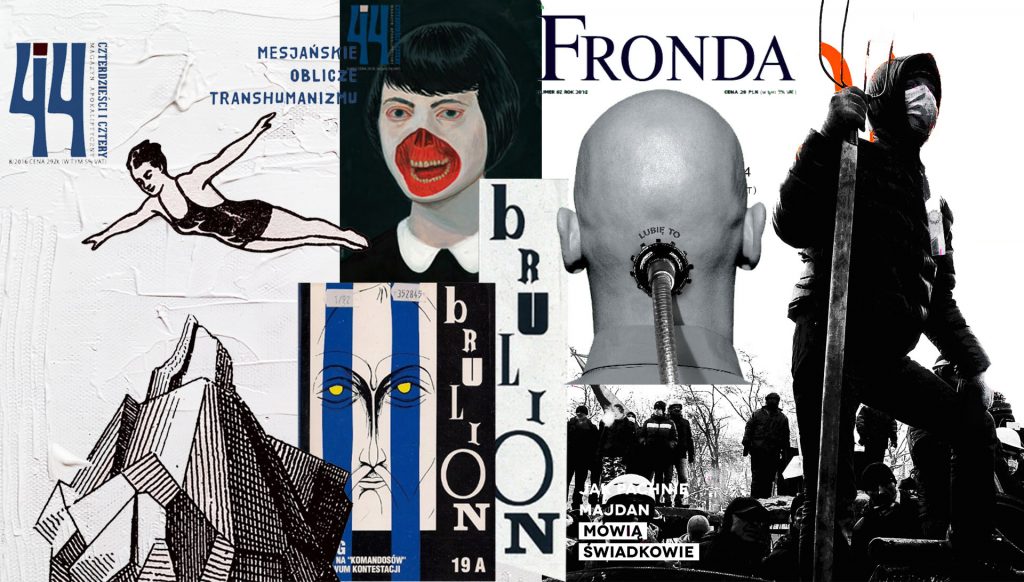
Collage of covers and artwork by Polish magazines Brulion, Fronda, 44/Czterdziesci i cztery. All images are courtesy of Brulion, Fronda and 44/Czterdziesci i cztery.
Anticommunism and historical memory
But in what sense is this literature ‘rightwing’? It is anti-communist certainly, and – more broadly speaking – anti-totalitarian. It portrays communism, and communist Poland, without any of the nostalgia, humour or justification implicit in much literary work published after 1989. The five, semi-autobiographical novels by Janusz Krasiński, published between 1992 and 2015, are a good example. The hero, Szymon Bolesta, is taken prisoner in his teens and held in German concentrations camps. After the liberation he spends two years in Germany, before returning home to be incarcerated and condemned to life imprisonment by the communists on false charges of spying. For Krasiński, prison represents the essence of the communist system – depriving people of any semblance of freedom or dignity. For Bolesta, there is little to choose between Nazism and communism – indeed, at times, the second seems the more inhumane. After his release in 1956, Krasiński’s hero discovers the banality of evil under communism. He feels that, in a spiritual sense, he had more liberty in prison. According to one critic, the novels offer ‘an epic representation of Poland as part of the prison created by the Soviet system’. They show up the ‘hidden metaphysics of the Polish People’s Republic … a slavish attachment to survival, even in its basest form’ and ‘a viral infirmity in the organism of a great, historic nation’.
Another example are the essays of Przemysław Dakowicz. In the collection Obcowanie (‘Interaction’, 2014), Dakowicz suggests that the communists sent Poles into a state of collective amnesia: ‘they sought to ensure that we would erase part of our tradition and abandon it as an unnecessary burden, for ever.’ This was by no means merely a semantic operation: ‘They performed an excision of live tissue. The earth was littered with the bodies of people who had different, non-communist memories.’ The effects were a change of elites, the deconstruction of memory, and a form of aphasia in which literature ‘stayed silent on issues central to the survival of the community’. Hence the ‘crucial importance’ today of a historical narrative written in a language that ‘blends tradition with modernity’.
Rightwing literature after 1989 typically addresses historical issues in order to fill in the ‘blood-soaked gaps’ left by communism’s attempt to ‘expunge memory’. The most popular subject matter is the ‘Cursed Soldiers’ (Żołnierze Wyklęci) – the anti-communist resistance fighters active after World War II. The novels of Wacław Holewiński, for example, combine fact and fiction to create literary portraits of men and women involved in the armed struggle against communism. Holewiński is no hagiographer, but rather seeks out what is human in his characters. This is true of novels such as Lament nad Babilonem (‘Lament for Babylon’, 2003) and Opowiem ci o wolności (‘Let me tell you about freedom’, 2012). Holewiński is also interested in paradox. The hero of the novel Honor mi nie pozwala (‘Honour forbids’, 2015) is Stanisław Ostwind-Zuzda, a Polish Jew and a major of the National Armed Forces (NSZ) – a group which fought both the Germans and Soviets during World War II. In 1945, Ostwind-Zuzda is arrested by the communist security forces and accused of being a fascist. Elżbieta Cherezińska’s novel Legion (2013) also recounts the fortunes of the NSZ and its denunciation by communist propaganda.
The Cursed Soldiers have also featured in poetry, particularly following the publication of Zbigniew Herbert’s poem ‘Wolves’ (‘Wilki’):
They lived by the law of wolves
History shrouds them in deafening silence
…
Electra has not wept for them
Nor Antigone buried them
And they will die to die again
In deep snow for all eternity
Herbert’s poem inspired Wojciech Wencel, author of the anthologies De profundis (2010) and Epigonia (2016), in which evocation of the partisans and their tragic fortunes features strongly. The same is true of Dakowicz’s collection of poems ‘The Little Meadow’ (Łączka, 2013). The title refers to an area of the Powązki Cemetery in Warsaw where the communist authorities hid the bones of resistance fighters by covering them with refuse. Later, gravestones for party dignitaries were installed on top. Dakowicz describes the exhumation and identification of the remains of these victims of communism, as a way of paying tribute to them. At the same time, he carries out a kind of exhumation of memory. For Wencel and Dakowicz, the Cursed Soldiers are a symbol of heroism, patriotism and tragedy, and of a country destroyed, violated and doomed to oblivion.
Another ‘blank’ filled by rightwing writers is the massacre of the Polish population in Volhynia by Ukrainian nationalists in 1943 and 1944, an event ignored for a range of reasons, both before and after 1989. Stanisław Srokowski addresses this in a collection of short stories (Nienawiść / ‘Hate’, 2006) and in the novel Ukrainski kochanek (‘Ukrainian lover’, 2008). The history of the north-eastern border regions of Poland, or Kresy, is another topic dealt with by rightwing authors. The area – which was within Polish borders for centuries but lost to the USSR after the Second World War – is evoked and sometimes idealised as a part of an authentic and multinational Poland, in which different national groups and religions lived peaceably side by side. In Wiesław Helak’s novel Nad Zbruczem (‘By the river Zbruch’, 2017) – winner of the Mackiewicz Prize in 2018 – Kresy is depicted as both beautiful and tragic. The novel tells the story of a landowning family that makes a valiant but hopeless effort to preserve its heritage and national identity in the face of threats from both the East (the Russian Empire and Bolshevism) and the West (Austro-Hungary).
Some of this literature reconstructs the post-war history of Poland from the point of view of victims or opponents of communism. The heroes of Piotr Zaremba’s epic novel Ruiny (‘Ruins’, 2017) are activists of the Polish People’s Party (Polskie Stronnictwo Ludowe) – the sole legal opposition party after 1945, brutally destroyed by the communists in 1947. Piotr Semka takes a similar perspective in his semi-autobiographical essay My, reakcja: historia emocji antykomunistow 1944–1956 (‘We, the reactionaries: a history of anti-communist feelings 1944–1956, 2015), an account of the Polish intelligentsia’s resistance to the new regime.
In an original collection of essays that has provoked wide comment, Jarosław Marek Rymkiewicz looks even further into the past. He is especially interested in historical moments that, in his mind, reveal the Polish national character: its rebellion against externally imposed and unjust political regimes, its affirmation of a radical notion of freedom, and its scorn for mortality, often displayed in apparently irrational or insane acts and gestures. Rymkiewicz simultaneously draws analogies between past and the present, transforming history into a commentary on contemporary Poland.
His extended essay Wieszanie (‘A hanging’, 2007) reconstructs an episode in Warsaw during the anti-Russian uprising of 1794, when an enraged crowd lynched and hanged a number of paid supporters of the Russian Tsar. Rymkiewicz reflects on the metaphysical dimensions of the event and seeks to vindicate the ‘feral’ crowd, at one point ironically regretting that communists weren’t similarly treated after ’89. His memoir of the Second World War, Kinderszenen (‘Scenes from childhood’, 2008), contains an account of the massacre of about 300 people during the Warsaw Uprising of 1944, caused by a German tank loaded with explosives. The memory prompts Rymkiewicz to defend the uprising, which is often criticized as having been politically irresponsible and romantic. He is particularly interested in the ‘mad and untamed’ side of the Polish personality, its refusal to be held captive and its struggle against efforts to colonise the country in the name of modernity and Europe – which is how Rymkiewicz sees the politics of Hitler’s Germany.
Historical revisionism and science fiction
Fantasised, counterfactual histories are also typical of rightwing literature. Maciej Parowski’s Burza. Ucieczka z Warszawy ’40 (‘Storm. Escape from Warsaw ’40’, 2010), for example, imagines a Polish triumph over the Germans in 1939, making the country the object of admiration worldwide. Poland’s victory is assisted not just by favourable meteorological conditions, but also by an efficient state and the resolve of the country’s political and artistic elites. The novel, like many others of a similar genre, is clearly therapeutic and compensatory: had it not been for World War II and the German and Soviet occupations, so its message, Poland would have become a modern, well-functioning state. Yet Parowski is also pointing out that history does not follow iron laws, and that events can be shaped by chance or the decision of a single individual.
Another, notorious example of revisionist fantasy is Piotr Zychowicz’s Pakt Ribbentrop-Beck. Czyli jak Polacy mogli u boku Trzeciej Rzeszy pokonać Związek Sowiecki (‘The Ribbentrop-Beck Pact, or how the Poles might have overcome the Soviet Union in alliance with the Third Reich’, 2012). Zychowicz’s criticism of the pre-war Polish government’s decision to reject concessions to Hitler in 1939 met with opposition even on the Right, as did his speculations about how the Second Polish Republic’s fortunes may have played out had its politicians agreed to attack the Soviet Union in alliance with the Third Reich. Revisionist interpretations of history are also to be found in the work of Rafał Ziemkiewicz. In his non-fiction book Złowrogi cień Marszałka (‘The baleful shadow of the Marshal’, 2017), Ziemkiewicz challenges positive images of inter-war Poland and Sanacja government of Józef Piłsudski popular not just in rightwing circles.
Rightwing Polish literature also has a predilection for sci-fi and has produced a range of generally gloomy visions of the future. Indeed, rightwing dystopias have become so prevalent since 1989 that some see fantasy and sci-fi as the exclusive domain of the conservative right. A good example is Ziemkiewicz’s novel Walc stulecia (‘Waltz of the century’, 1998). The action takes place in Reims, the city where Clovis I, the King of the Franks, was baptised and whose cathedral is a symbol of the spiritual and economic power of Christian Europe. In the novel, which is set in the second half of the 21st century, the cathedral is no longer a place of worship but a venue for orgies. The ‘ruminants’ who dance and copulate in the cathedral are redolent of figures from Aldous Huxley’s Brave New World.
In Europe, Ziemkiewicz suggests, totalitarianism threatens – a soft and colourful kind, but totalitarianism nonetheless. Life in his brave new Europe is an endless carnival. Nothing that happens is true or real; everything is spectral. The main protagonist, Orin Bethlen, remarks that the times have ‘transformed everything into pale, powerless apparitions, summoned by a single click on the control panel, and as easily despatched’. His girlfriend adds: ‘we’re living with shadows, and all we do is produce new ones. Cathedrals and castles, built centuries ago, are still there, but what about us? What will we leave behind? Turn off the power and everything’s gone.’
It is the ‘Day of Affluence’, yet everything is illusory, even affluence itself. Politics has become a fiction, while democracy has merged with public relations and is run by experts working for an organisation for the ‘Creation of Authority’. They shape intellectual and political elites for the ‘ruminants’, who think that they are sovereign, when in fact real power lies elsewhere. The world is ruled by vast supranational corporations combining banks, companies, media and political parties into ‘a single anthill similar to an ancient empire, with armies of specialists at its disposal’. Technological development enables complete surveillance and ‘profiling’ – the subjection of ‘persons’ to personality change, according to the needs of the authorities.
A recent contribution to the sci-fi genre is Paweł Lisicki’s widely debated novel Epoka Antychrysta (The age of the Antichrist, 2018). Set in Europe in 2217, a new Pope has been elected by the papal conclave. His chosen name is Judas and he takes the ideology of the contemporary Left to its final – devastating – conclusion. The novel draws on the famous dystopian works of Vladimir Solovyov and Robert Hugh Benson, although Lisicki adds: ‘My vision is more terrifying still. I imagine the Antichrist not as an outside force challenging the Church, but as a power that has taken it over.’
The fantasy literature discussed here is not just dystopian and catastrophising, but anti-modern. It communicates a nostalgia for a European civilisation based on a metaphysical world view. In Dziennik kwarantanny (‘Quarantine diary’), the critic and essayist Tomasz Burek writes of:
The disappearance of any capacity for attention and focus; a loss of the logic of choice, of the desire and ability to differentiate between what is real and what is not, between truth and falsehood, good and evil; an excruciating sense of detachment from reality, as though everything, life and culture together, were a delusion, a fantasy born in someone’s dark mind. These are the results of the annihilation of an order based on the certainties of metaphysics.
Hence the popularity, in rightwing literature, of writers such as Robert Hugh Benson, T.S. Eliot, G.K. Chesterton, Jacques Maritain, Georges Bernanos and Ernst Jünger. They represent a Europe rooted in moral values – Christian, conservative and close to the hearts of Poland’s rightwing writers. It is a Europe that serves as a model for their books.
Rehabilitations: Nationalism, anti-modernism, Catholicism
Post-1989 rightwing writing in Poland also likes to rehabilitate national traditions once attacked by communism and by the left in general. These include romantic messianism and above all Sarmatianism – a cultural movement associated with the nobility of the First Polish Republic, often represented under communism as obscurantist or chauvinist, and accused of bringing about the fall of the Polish state at the end of the 18th century. Since 1989, the right has presented Sarmatianism as having combined Polish identity with openness to both Christian and Classical traditions, and as having been deeply religious. Importantly, Sarmatianism is also considered to have offered unique model of republicanism, in which individual freedom and the liberty of national groups were protected. Krzysztof Koehler is a good example of this tendency. In his essays, anthologies and poetry, Koehler seeks to show Sarmatianism as a tradition that is valuable, relevant and necessary. The result has been talk of a revival of the Sarmatian tradition in Polish culture after 1989.
Criticism of modernity and post-modernity also features regularly in rightwing writing. The essayists Cezar Michalski, Ryszard Legutko and Bronisław Wildstein are worth mentioning. All three draw analogies between communism and postmodernism and share an anxiety about the threat that influential western ideologies and philosophies represent for individual and national freedom. Wildstein raises these fears in his fiction, which portrays postmodern liberalism as a mask for nihilism and a tool for former communists, who have resumed their mission in the new Poland. The biblical title of Wildstein’s most famous novel, Dolina Nicości (‘The valley of the shadow’, 2008) offers a metaphorical diagnosis of the state of Poland since 1989. The novel tells the story of a Warsaw journalist who discovers that one of the country’s most respected intellectuals, widely viewed as a moral authority, was formerly an agent of the communist secret police. When the journalist exposes the evidence, his reputation is shredded by a media run by former communists and their covert collaborators.
Writers who sympathise with the Right tend to see the New Poland as being in the grip of networks more or less openly connected to the former Peoples’ Republic. They see the country as being undermined by predatory, greedy capitalism, which decimates traditional communities while destroying the weak. The stories and novels of Marek Nowakowski, for example, reflect this point of view. However for many rightwing writers, the Third Polish Republic’s greatest transgression has been its failure to prosecute the former communist regime and those who committed crimes under its auspices. In Wojciech Tomczyk’s play Norymberga (Nuremberg, 2006), the hero – a colonel of the communist intelligence services with numerous victims on his conscience – calls for a trial in Poland similar to those held in Nuremberg after World War II. He tells his interlocutor, a young female journalist, that the scale of the crimes he and other communists committed compares to those of the Nazis. In an indirect appeal to the new Poland, the colonel demands to be charged while also accusing himself and the former regime. ‘That’s what communism is. It appeals to the worst in us all,’ he says.
Although it would be a wrong to suggest that, in Poland, Catholicism is synonymous with the right, it is nevertheless an important feature of rightwing literature after 1989. In religious essay writing, Christianity is either addressed from a historical and cultural angle, or theologically and focused on the present. Marta Kwaśnicka represents the former perspective, exploring connections between Catholicism and European culture, while Dariusz Karłowicz examines the faith of early Christians. A slightly different approach is taken by Paweł Lisicki, who analyses contemporary Catholicism, pointing to the perils it faces both within and outside.
Religious poetry is equally important, offering an apology for religious faith and depictions of the experience of Catholics today. Affirmations of faith are often underpinned by doubt, but the existential and aesthetic experience remains metaphysical. Wojciech Wencel’s ‘sketches’ on culture and literature are manifestos for this position. He designs a strategy for modern classicism rooted in the Christian tradition and ‘based on the gift of faith, emerging from daily experience of the Divine order and Providence, that accepts the responsibility flowing from this’. In the epic poem Imagio mundi (2005), for example, Wencel’s hero wanders the ‘barren earth’ of contemporary Europe in search of lasting values, God and the fatherland.
Polarization and democratization
Rightwing Polish writing is abundant, varied, and hybrid. It is also sometimes inconsistent, particularly in its assessment of the national or religious tradition. Poland’s literary right is multi-generational. Janusz Krasiński was born in 1926; Jarosław Marek Rymkiewicz in 1935; Bronisław Wildstein in 1952, Paweł Lisicki in 1966 and Przemysław Dakowicz in 1977. Each of these writers works in a range of genres and literary forms, although poetry and prose are dominant. Poetry tends to lean towards the classical, with references to the romantic and Sarmatian traditions, dialogues with the past, and stylisation. Prose covers essays and novels of various genres: fantasy and sci-fi, dystopian, political or historical. The aesthetic of rightwing literature is mixed and, like in the interwar period, oscillates between classical and modern.
How does modern rightwing writing in Poland connect with the literature of the 1920s and 1930s? On one hand, there are elements of continuity: anti-modernism, traditionalism, Catholicism, anti-communism, patriotism (at times combined with a critical stance towards perceived national flaws), anti-elitism, catastrophism and anti-urbanism. But the anti-Semitism so evident in the rightwing literature of the 1920s and 1930s is notably absent. Equally, the figure of the national leader and motifs of national strength are less prominent. Instead, one finds new elements: memory, Eurocentrism (alongside scepticism towards globalisation and European institutions), and a critical attitude to liberalism and postmodernism. The ‘Asian threat’, which featured in the interwar years, has been modified to ‘threats from within’, in particular from the left.
Given its porous boundaries, it is hard to specify what place rightwing literature holds in contemporary Polish culture as a whole. Critics see it as a ‘niche’ phenomenon, a closed space, nurturing writing that is tendentious and worthless. It is true that for many years rightwing Polish literature existed in seclusion, with its own critics and readership. Yet the achievements of individual writers, the awards and critical acclaim they receive, speak for themselves.
The continued existence of rightwing literature is not surprising, given that there has also been a rise of ‘engaged’ or ‘leftwing’ literature in Poland. The growing significance of politics in Poland and worldwide necessarily creates polarisation. In Poland, this is scarcely a novelty: rightwing tendencies in culture and literature are far from new. Under communism, their absence was enforced and artificial. That a literary right wing exists in Poland today is evidence of a healthier body politic, and one of the consequences of democratisation since 1989.
